Follow my simple Pork Temperature Chart to cook your favorite pork chop recipes and more to perfection! This chart has all the information you need for pork tenderloin, pork chops, roasts, and even ham. Let’s get started!.
Some people in my family don’t like pork recipes as much as I do. If you eat too many dry, overcooked pork chops, you might think pork isn’t as good as beef or chicken.
But it has a lot to offer: if you cook pork just right, it turns into a tender, juicy protein that takes on the flavors of whatever you serve it with. Best of all, pork is more budget-friendly than ever, so you can save some money cooking it, too.
This pork temperature chart is great if you’re new to cooking pork or just want a better way to do it. Not to mention, I’ve included some of my family’s favorite pork recipes so you can test your skills!.
In general, the USDA says that pork chops and roasts should have an internal temperature of at least 145°F.
But depending on the cut, some cuts, like ground pork or precooked ham, may need a lower or higher internal temperature.
Keep reading to learn how hot different types of pork cuts should be inside, like pork chops, tenderloin, ham, and more!
No matter how they are cooked, bone-in or boneless pork chops must reach an internal temperature of 145°F to be fully cooked. Even though the standard used to be higher, if you cook your pork past 145°F, it is already too done.
Use an instant read meat thermometer to measure the temperature of your pork chops. To get the best results, take it off the heat as soon as it reaches the right temperature inside and let it rest for a while before cutting it.
As a home cook who loves hosting dinner parties, pork chops have always been one of my go-to entrees. Their quick cooking time, mild flavor, and affordable price make bone-in or boneless pork chops an easy crowd-pleaser.
However I used to struggle with overcooking them into dry leathery hockey pucks. No matter how carefully I watched the clock, my pork chops would turn from juicy and pink to grey and tough. What was I doing wrong?
After some research and chats with butchers and chefs, I realized the secret was focusing less on total cook time and more on checking the internal temperature. When I started actively monitoring the interior temp of my chops it was a total game-changer!
If you want to take your pork chop cooking skills from dry and disappointing to moist and mouthwatering, read on for my guide to nailing the ideal internal temperature every time.
Why Internal Temperature Matters
With quick-cooking cuts of meat like pork chops and chicken breasts, looks can be deceiving. Just because the outside seems browned and “done” doesn’t mean the inside has finished cooking.
Taking the internal temperature is the only reliable way to ensure the chops have reached a safe minimum cooking point to kill any potential bacteria. It also prevents overcooking which leads to dry, flavorless meat.
I highly recommend having an instant-read digital meat thermometer on hand whenever cooking pork. They are inexpensive, super easy to use, and take the guesswork out of determining doneness.
The Minimum Safe Temperature
So what target temperature should you aim for when cooking bone-in or boneless pork chops on the stove, grill or in the oven?
According to USDA food safety standards, 145°F is the minimum safe internal temperature for pork. Cooking to at least 145°F eliminates the risk of harmful bacteria like salmonella or parasites.
For extra peace of mind, some home cooks target closer to 150°F. But anything above 145°F is considered safe for consumption by food safety experts.
Allow for Carryover Cooking
Once your pork chop registers 145°F internally, it needs a brief resting period before serving. The temperature will continue rising about 5-10 degrees during this time due to carryover cooking.
Let chops rest for 3-5 minutes after removing them from the heat source. This allows the interior heat to evenly distribute for consistent doneness from edge to edge.
Skipping this rest time means the center could still be under the safe 145°F mark right when you slice into it. Be patient!
Adjusting for Personal Preference
While 145°F meets safety standards, you can tweak the final internal temperature slightly based on your own taste and texture preferences:
-
145-150°F – The juiciest option, with a hint of pink. Ideal for pan-seared chops.
-
150-155°F – A good middle ground; pink center with firm texture. Great for grilling or baking.
-
160°F+ – Cooked through with no pink; can dry out if overcooked. Best for stewed chops.
I suggest starting at 145°F for the most tender and flavorful chop. But feel free to experiment to find your personal ideal temperature!
Should You Go Above 160°F?
Cooking pork chops to temperatures approaching 165°F or beyond can make them dry, chalky and tough. The meat loses its natural juices and tenderness above 160°F.
The only reason to consider exceeding 160°F is if reheating fully cooked chops or cooking pork that was brined or marinated raw. In those cases, hitting 165° ensures any bacteria from the marinade or leftovers is eliminated.
But for fresh, unmarinated chops, there’s no benefit to exceeding 155°F-160°F max. Stick to lower temps for the best texture.
Pro Tips for Accurate Temperature Reading
While today’s digital meat thermometers make it easy to monitor internal pork chop temp, there are a few tips for ensuring an accurate reading:
-
Insert thermometer into thickest part of chop, away from bone.
-
Wait 15-20 seconds before recording temperature so it can stabilize.
-
Take temps in a few different spots to confirm consistency.
-
Double check with an instant-read thermometer near end of cook time.
-
Calibrate your thermometer regularly for precision.
Common Pork Chop Mistakes to Avoid
Now that you know the ideal internal temperature for pork chops, here are a few other common mistakes to avoid:
Mistake: Not letting chops rest before slicing.
Fix: Always rest for at least 3 minutes after cooking for juices to redistribute.
Mistake: Assuming browned exterior = done interior.
Fix: Use a thermometer to check inner temp instead of appearances.
Mistake: Overcrowding chops in the pan.
Fix: Cook chops in a single layer with space between for even browning.
See? Monitoring the internal temperature really is the key to perfect pork chops every time!
From Stovetop to Table
Armed with the knowledge of the proper interior pork chop temperature, you can now cook, rest and serve chops like a pro!
For ultimate juiciness and flavor, target 145°F and allow the temperature to carryover during resting. Then slice, sauce, and enjoy your succulent chops.
:max_bytes(150000):strip_icc()/SPR_3981295-timing-the-cooking-for-pork-chops-5a985c9e31283400373b2916.png)
Pork Shoulder Temperature (Pork Butt)
| Cooking Method | Internal Temperature |
|---|---|
| Smoked Pork Shoulder | 195°F to 205°F |
| Grilled Pork Shoulder | 195°F to 205°F |
Technically, pork shoulder, which is also known as pork butt, is done when it reaches 145°F. However, like beef chuck roast, this cut of meat tastes better when you cook it for longer.
Shoulder and butt are the best cuts of pork for pulled pork. Whether you grill, smoke, or slow-cook the meat, you want it to be fall-apart tender so it’s easy to shred and tastes the best.
For smaller pork butts, you may not need as high of a temperature. Aim for between 180°F to 190°F for a smaller cut.
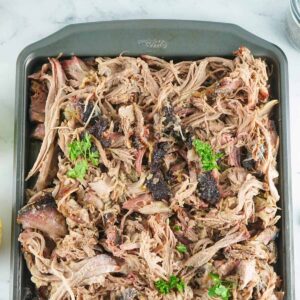
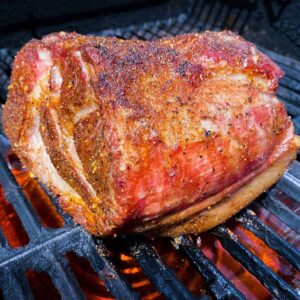
| Roast Pork Cut | Internal Temperature |
|---|---|
| Bone-in Pork Loin (rack of pork) | 145°F |
| Boneless Pork Loin | 145°F |
| Pork Tenderloin | 145°F |
Just as with pork chops, the ideal pork roast temperature is 145°F. When roasts reach 140°F, take them off the heat and let them rest for at least 10 minutes until they reach room temperature.
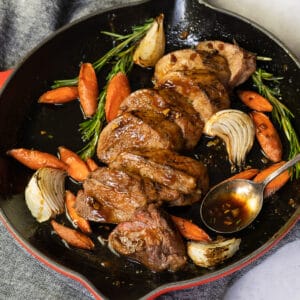

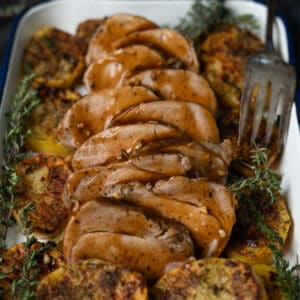
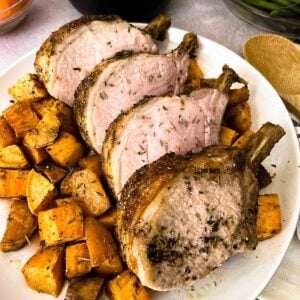
| Pork Ribs Cut | Internal Temperature |
|---|---|
| Baby Back Ribs | 198°F to 200°F |
| Spare Ribs | 198°F to 200°F |
| Country-Style Ribs | 205°F to 210°F |
| St. Louis-Style Ribs | 200°F to 205°F |
A higher temperature is better for pork ribs than the USDA standard. This is also true for pork shoulder and pork butt. For fall-off-the-bone results, cook all ribs to above 195°F.
However, some people prefer their ribs less fall-off-the-bone than this level of doneness. Aim for at least 145°F and no more than 180°F if you like your ribs to have a bit more chew. Cook them slowly.
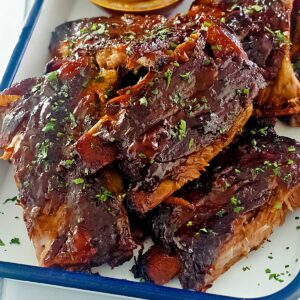

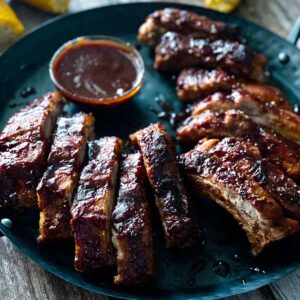
| Style of Pre-Cooked Ham | Internal Temperature |
|---|---|
| Boneless Ham | 140°F |
| Bone-in Ham | 140°F |
| Spiral Ham | 140°F |
| Ham Shank | 140°F |
| Ham Steak | 145°F |
Because most hams are purchased pre-cooked, they require a slightly lower temperature than pork purchased raw. If you purchase your ham uncooked, make sure to reach an internal temperature of 145°F.
If you don’t want your ham to dry out or get too cooked, you should use ham glaze to baste it before, during, and after cooking, and cover it with foil at the right times.
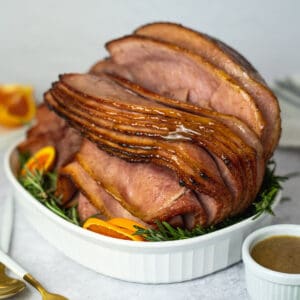
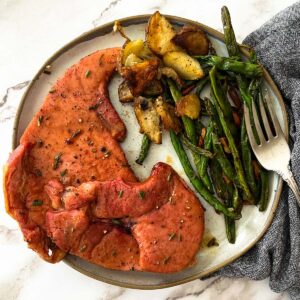
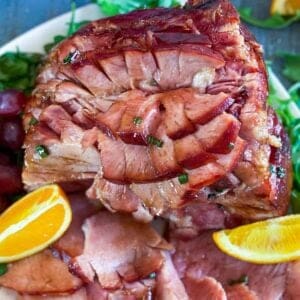
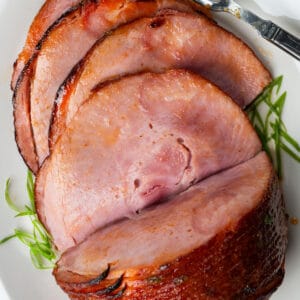

| Recipe | Internal Temperature |
|---|---|
| Ground Pork Burgers | 160°F |
| Ground Pork Meatballs | 160°F |
| Ground Pork Meatloaf | 160°F |
| Ground Pork Chili | 160°F |
| Ground Pork Tacos | 160°F |
| Plain Ground Pork | 160°F |
Food safety rules say that ground pork should always reach an internal temperature of 160°F, no matter what recipe you use or how you cook it. Make sure to use a meat thermometer to check the temperature of ground pork as necessary.
Because it is ground, ground pork needs to be cooked at a higher temperature than other cuts. This is because the process of grinding exposes the meat inside to bacteria from the outside. Cooking to 160°F kills this bacteria.
Pork Internal Temp FAQ
Some cuts of pork, like pork chops, cutlets, and roasts, are safe to eat at 145°F. If you cook them any higher, they are too done. Pork ribs are best cooked to a temperature above 190°F. However, ground pork requires an internal temperature of 160°F to be safe to eat.
There’s nothing wrong with pork being a little pink on the inside. It depends on how it was cooked (smoking makes meat more pink). Just like beef, this color of pork is considered “medium-rare”. To be sure that your pork is safe to eat, you need to use an internal meat thermometer to make sure that it reaches 145°F on the inside.
Cook Pork Chops to Perfection: The Ultimate Guide to Internal Temperature
FAQ
Are pork chops done at 165?
Is pork done at 145 or 160?
Is pork chops still pink at 145?
Can you cook pork chops to 145?
What temperature should a Pork Chop be cooked at?
You can rest assured that if your pork chop’s temperature is 145 degrees F, you’ll have safely-cooked meat that’s moist, juicy, and just slightly pink in the center. Whether the pork is boneless, bone-in, and regardless of the cooking method (i.e. grilling, roasting, frying, etc), the internal temperature should be the same.
What temperature should pork be cooked at?
“This is why whole muscle cuts of pork like roasts and chops are safe, juicy and flavorful at 145° internal temperature with a proper resting period.” If a medium-rare 145-150° isn’t desirable, then try additional temperatures from the National Pork Board: medium (150-155°), medium-well (155-160°) or well done (160°).
How do you check the internal temperature of a Pork Chop?
The easiest way to check the internal temperature of pork is by using an instant-read meat thermometer. To do so, slide the thermometer into the middle of the thickest part of the chop. Take care to stay in the middle of the chop without breaking through to the pan, which will affect the reading.
How thick should pork chops be?
Cuts of pork are safe to eat when the thickest part of the meat reaches an internal temperature of 145°F. Thicker cuts of bone-in pork chops tend to be more tender than thinner and/or boneless chops. We recommend chops that are at least 1-1.5 inches thick for the best results. Want to save this recipe?
